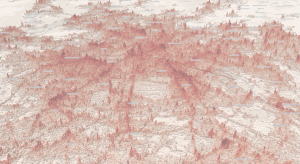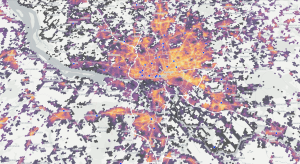
Analyses of individual locations and their catchment areas are crucial for making data-driven location decisions, but they often overlook an important aspect – the impact of neighboring shops and competitors. To address this issue, network analyses can be performed to better understand the interactions and gravitational attraction between shops.
Targomo’s Statistics Context API has some deep functionality, one of which is an implementation of our multigraph API with statistics datasets as the aggregation geometries. This allows us to run complex aggregations – in this case the Huff model. This allows us to calculate the likelihood of certain demographic groups coming to a location and the likelihood of a location attracting the revenue potential of a region.
Interactive demo: Probable branch network visitors
In the example below, we are simulating two store networks: our network (black pins), and the competition: (gray pins). For simplicity’s sake, we are assuming that all locations are equally attractive, aside from distance.
The color of the statistics cells represent how likely the inhabitants at that location are to visit a store in our network. Since the cells contain population data, we can therefore multiply the likelihood by the statistic value to get a total potential visitor count.
How it works:
- Move the pins to change the location of the shops (dark = own shops).
- Select the target group
- Read how many relevant people you are reaching
- Change the colour scheme for different visualisations
Background: Gravitational model and Huff model
One important outcome of network analyses is the determination of how demand is distributed among existing locations, including both in-network and competition. Gravitational models, which measure the force-based interactions between nodes in a network, are often used to determine this distribution. In the context of retail consumer analytics, the concept of gravity refers to the attractivity of a retail location to potential customers.
By utilizing network analyses and gravitational models, we can gain valuable insights into customer behavior and make informed decisions about location strategies. Understanding the interplay between neighboring shops and the attractivity of each location can help businesses optimize their presence and stay competitive in today’s market.
The Huff model (or Huff’s model), developed by David B. Huff in 1963, builds on the gravitational model. It is a widely used tool for predicting the probability of a visitor to a site as a function of the distance of the site, its relative attractiveness (compared with other sites), and the relative attractiveness of alternatives. In other words, it predicts the likelihood of people preferring one location over another based on factors such as distance, attractiveness and competition.








